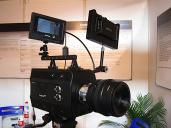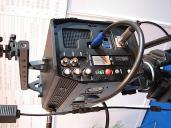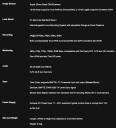
-
Very interesting, I hope it comes out to shake this industry up. If you follow the sensor and processor industry, you can see the technology is here for affordable raw camera. But it is those big companies that are holding it. I can't see one technological industry where progress is so low or intentionally crippled by marketing. When 8bit codec are the norm for $ 5000 camera when in the photo world for 1/10th of the price you are using 12 bit raw files.
When you think the power of the little gh2. More so the 12 fps 24 megapixel Sony a77 throughput is the same as about 144 fps 2 k raw output. This tell you that with the hardware processing of the A77 with a 2k chip and you would easily get a 24 fps 2k raw cinema camera. -
awesome! well, for sure this is no answer to RED EPIC as 2K 24FPS is not quite 5K 120FPS:) and EPIC does 2K at 300FPS at higher dynamic range, and is much smaller and lighter. But the EPIC is a 50,000$ camera:). resolution is generally speaking vastly overrated and having a 2K native sensor, is probably going to prove awesome for lowlight as pixels should be much larger! and 2k is really a great resolution even for cinema, a bit more than fullHD, just right. If they can deliver what they claim for the price they claim, that will be a first in the cinema camera market. LOL good luck to them!
oh, and for god's sake, when will Chinese manufacturers start taking marketing seriously? Is that guy for real? They need their own "Tedd from Red" :) -
pics

 IMG_0211.jpg600 x 450 - 94K
IMG_0211.jpg600 x 450 - 94K
 IMG_0209.jpg600 x 450 - 112K
IMG_0209.jpg600 x 450 - 112K
 Kinefinity.jpg640 x 709 - 117K
Kinefinity.jpg640 x 709 - 117K -
@ danyyyel exactly
-
Looks Suspiciously similar to a Phantom... Probably the OEM for a lot of phantom parts decided to make their own cam.
-
They should I think include some more capabilities for it to be a viable investment. One thing is at least a 60 fps burst mode. Even if it only for 30 second. It would make it a much more complete package.
I also hope that they understand that it is not a small investment and that a certain standard of quality and consistency (sample variation) is not the same than a $150 follow focus. I prefer a very robust $8000 camera to a $ 7000 one with some small cuts that will ruin the whole experience. -
I guess this is just beginning. You know Chinese folks. They will keep going and going and going.
-
I believe in Chinese. Where they were 40 years ago and where it was the U.S.? And where are they now and where is the U.S.?
-
We have topic about BIRTV:
http://www.personal-view.com/talks/discussion/768/birtv-2011-exhibition#Item_3 -
Well... I really don't know where Chinese are going. But it's easy to tell where Americans are going.
Half of USA population will be obese by 2030. http://blogs.phillymag.com/bewellphilly/2011/08/26/obesity-to-skyrocket/ -
@stonebat
You are always late, browse Blog category :-) -
It's ok. I can't delete :)
-
@Vitaliy_Kiselev Don't you think that perhaps this merits it own thread. Compared to the slew of rigs, this is potentially (over abused word) game changing and very different from the rest.
My complain with Chinese things is that sometime it is an ever evolving product. The problem is that the first users look more like guinea pigs. The filter holders are not adequate, revised gear box because it had too much play, the attachment should be like that etc, etc... it is good to be reactive, but it is better if you plan to make things from the start. Imaging if tomorrow you buy it and then 6 month latter they bring an updated version with 60p output for slow motion because have been clamoring for it. More so that it is a $ 8000 investment and not a $ 300 follow focus.
-
>Don't you think that perhaps this merits it own thread.
I do think that it deserves own topic. As you can see topic is not closed for exact this reason :-)
>my complain with Chinese thing is that sometime it is an ever evolving product. The problem is that the first users look more like guinea pigs. The filter holders are not adequate, revised gear box because it had too much play, the attachment should be like that etc, etc
Your complain is not about Chinese, but about life. :-)
Ideally someone must do all right from the start and make it complete and perfect.
In reality it never happens.
And fast iteration common for Chinese manufacturers lead to very good result in very short time.
-
It works like Starcraft game. Build just enough marines and firebats. By the time most of them die, build enough advanced units. Repeat the cycles. Eventually build best units.
If one trys to build best units on day 1, more likely his company will go out of business. It takes time to build experience and reputation and find out user feedbacks.
From a buyer perspective, if there is opportunity to make a lot more than $8k, why not try new gadget out? -
The video needs English subtitles. If they're going to have someone mangle the English language, at least let some hot Chinese girl host it. They need to hire Olivia.
-
Im always down for innovation. Let's see how it holds up in rigorous testing. The Chinese are not exactly known for their superior manufacturing quality, and this is a major factor for DP's. I applaud their efforts, and will give them the benefit of the doubt until I can do my own testing.
Im especially interested in the S16mm model for documentary work. Having an affordable 2k RAW image with some depth for focus would be tremendous. I shoot a lot of wildlife, and would LOVE to have 2k logarithmic RAW at my fingertips, especially with my long Canon focal lengths and the crop factor of a S16mm chip. Affordable 2k RAW was only a matter of time for a consumer market that thrives on content and innovative shooters like you guys.
This system also poses an interesting question. Where did they get the technology? They must have been offering top dollars for a serious digital imaging engineering team and the intellectual property. If anyone has the ability to draft a system, align the manufacturing models, and start selling affordable products it's the Chinese. This actually reminds me of the A-CAM dll by Ikonoskop.
-
>This system also poses an interesting question. Where did they get the technology?
It is sensor with special board and computer (Intel based) using 2.5" SATA SSD, all in one :-)
This will be design common in coming years.
-
If you look at a site like this http://image-sensors-world.blogspot.com/ , you will see that it is not alien technology at all. There are a lot of these companies that do the sensor, most of them are for machine vision surveillance market. But most of the same principal applies to our video camera. Many have kits, where you have the sensor and fpga board to kickstart the development.
Those Chinese manufacturer are just assembling those parts and putting them to spec for cinema cadence and filming. It might not be as simple as I making it be, but basically it is it. They identified the market and saw some technologies (there have been a number of S35 size coming up the last 18 month) that would fulfill most of the needs at a competitive price. Some of the sensors have big big spec (beyond red) like the Cypress vita, which is a 25 megapixel chip shooting at 53 fps and about the size of full frame Canon 5d chip. But the price and tech needed would surely be very high. -
Can you overclock it, and does it play Angry Birds? Just kidding - but yeah - I'd love to shoot something for these guys as a test!
-
A sensor that comes in a kit? Surveillance market?
Sounds like a real custom job designed for the craft of the modern cinematographer... -
It might not look too glamorous but a cine camera as other camera is a sensor plus a computer(fpga ) which will process the data from the sensor to output it for monitoring and storage. I am not saying that they just bought a kit and assembled it and put it in a box. But it is not as if they had to develop the sensor, processor, etc. The Silicon Imaging SI-2K came from such a project.
-
@danyyyel
"Imaging if tomorrow you buy it and then 6 month latter they bring an updated version with 60p output for slow motion because have been clamoring for it. More so that it is a $ 8000 investment..."
How would that be different to what PanaSony does?
The Chinese (Foxconn) were going to manufacture the "Once upon a time in La-La Land" affordable Scarlet for RED. Looks like they will soon do it in another way. I really hope they do...and soon. Unlike the "Big Noise/No Action" Red marketing hype, the Chinese tend to quietly get it together first and then release something impressive.
@stefanos
"oh, and for god's sake, when will Chinese manufacturers start taking marketing seriously? Is that guy for real? They need their own "Tedd from Red" :) "
Ha ha...I guess I deal a lot more with the Chinese than most people...so I make allowances for presenters like "that guy"...but I prefer that straightforward low-key approach to some of the proselytizing bullshit artists on the Red and Microsoft, etc. payroll. -
More info ala Koo's site- http://nofilmschool.com/2012/02/latest-chinese-kineraw-digital-cinema-camera/
Sounds interesting for the price tag. One item that bugs me is the cmos sensor. Someone needs to move past it at some point. The thing that really puzzles me is the super 8 version. WTF? Can someone 'splain?
-
WOW! People who dream of recording a cameras RAW Data (Video) should first read all the commends from Dan Hudgins on vimeo.
after that they might appreciate what a little camera like the GH2 does before a usable image can be seen. Sorry GH2 for complaining about your banding :-)
Example:
Dan Hudgins 4 weeks ago
Hi Ted,
As I mentioned in the comments for the #A1 lens test reel, you cannot look at the RAW footage without grading and seem much as it looks like this:
1) Out of focus because there has not been anti-OLPF compensation applied.
2) Very dark almost black at the higher ISO because the camera records sensor linear data, most of the information is in the lower percent of the signal, with two stops of head room, 18% Gray is at about 5% signal depending on the black offset.
3) Almost no color at all, because the Bayer filter in Bayer sensors is de-saturated to allow higher ISO and luma detail in all pixels, the color needs to be increased through a chroma matrix tailored to the sensor type, light source, and subject matter.
4) EI/ISO adjustment curve is absent so the image brightness would vary from one shot to another. Part of the de-Bayer process is to softclip the highlight information to fit within the range of an 8 bit display. The camera shoots 12bits linear data which cannot be displayed on a computer monitor with the slope angle at the same angle as when shooting, to squeeze the tones into a viewable range the RAW data needs to be run through a LUT to correct for the EI/ISO used at the time the images were shot.
5) White balance, the RAW data has a green bias and not white balance, its True RAW data, so no mater what color light you shoot under the sensor is recorded in the same way, so the data levels vary depending on the K value of the light.
I have a workprint mode in my de-Bayer program that can output as fast as possable workprint quality without color correction or white balance and EI/ISO curve, but its of limited use at low EI/ISO and almost useless for high EI/ISO as the images would be too dark to see well unless you turn all the grading room lights off and turn the monitor brightness up.
I do have color corrected workprint mode also, for fast conversion, I running the anamorphic footage I have shot with date+TOD and SMPTE time code burn in so that my Brother can edit it on his computer using a windows program and then I can set the head and tail edit points from the time code in the edited version since its on the screen as a burn-in from the camera's meta-data in tag 50740 of the DNG frames. My software can also burn-in the slate information from the camera's built in auto-slate that has a beep and marks the DNG meta-data for the head and tail beep frames, that way I can read off the scene and take numbers off the first frame from the auto-slate to find the source shot folder as needed.
I've been grading the shots hard because Kinefinity (tm) said that they wanted the images with more contrast, I had been trying to show the long tonal scale of the camera but doing that tends to make the images look a bit flat and un release print looking.
Movie film is shot negative and printed this way:
1) Camera negative
2) Master positive
3) Duplicate negative
4) Release print
That results in the tones being up-side-down half the time and that affects the way resolution, gain, and saturation vary in the shoulder and tone of the release prints transfer curves. There are also dye bleed and S-curve effects.
My de-Bayer program has processing steps to get away from the HD look and simulate some of the more 35mm negative-positive-negative-positive look of a release print.
Its possible to process the RAW data to get a bad camcorder look, but if you want that you don't need to get a Digital Cinema Camera you can get a camcorder.
Thank you for the complements. I'll try to make some less hard grades on some other sample reels when I have time, and I'm also looking forward to shooting True RAW for monochrome to get Black and White film stock simulation, as I have control over the matrix, its not set to NTSC or PAL like in a camcorder, I can simulate Ortho, Pan or Super-Pan film stocks to get the 1910's, 1920's or 1930's film looks, maybe.
Each camera's sensor has its own unique look, in part because the dyes used in the Bayer filter are proprietary for each chip maker.
If you want to see what True RAW data looks like, you can download the DNG frames from the Acam dII (tm) web site, and the use the free program DNG_validate.exe (tm) that comes in a ZIP file on Adobe (tm)'s web site to convert the DNG to TIF that you can open in some graphics viewer like XNVIEW. DNG_validate.exe (tm) is a free program made available by Adobe (tm) for developers to check the header on True RAW DNG files the make for compliance with the open CinemaDNG standard for True RAW Digital Cinema Cameras. Unless they have changed it, you should see a very dark, greenish, soft focus result.
I should add that True RAW data has constant grain noise that is more film-like grain than the mosquito noise caused by H.264 compression in 8bit HDSLR recording. In those compressed cameras de-Noise is burned into the recorded images, but in a True RAW CinemaDNG camera the de-noise is done in post production so you have control over how much grain noise you get, and its new grain on each frame, just like film grain, and unlike key-frame compression such as MPEG2 for DVD where grain can stand still for 4 frames of so giving an un-film like result of gain that pulses rather than being like constant raindrops.
I used the temporal noise reduction built into my free de-bayer program, DANCINEC.EXE (tm), to prep the frames before compression for upload here to minimize the build up of MPEG4v2 (H.264) related mosquito noise and block artifacts and to minimize the kbps required to get the images encoded so more bandwidth would go to detail rather than noise.
Howdy, Stranger!
It looks like you're new here. If you want to get involved, click one of these buttons!
Categories
- Topics List23,992
- Blog5,725
- General and News1,354
- Hacks and Patches1,153
- ↳ Top Settings33
- ↳ Beginners256
- ↳ Archives402
- ↳ Hacks News and Development56
- Cameras2,367
- ↳ Panasonic995
- ↳ Canon118
- ↳ Sony156
- ↳ Nikon96
- ↳ Pentax and Samsung70
- ↳ Olympus and Fujifilm101
- ↳ Compacts and Camcorders300
- ↳ Smartphones for video97
- ↳ Pro Video Cameras191
- ↳ BlackMagic and other raw cameras116
- Skill1,960
- ↳ Business and distribution66
- ↳ Preparation, scripts and legal38
- ↳ Art149
- ↳ Import, Convert, Exporting291
- ↳ Editors191
- ↳ Effects and stunts115
- ↳ Color grading197
- ↳ Sound and Music280
- ↳ Lighting96
- ↳ Software and storage tips266
- Gear5,420
- ↳ Filters, Adapters, Matte boxes344
- ↳ Lenses1,582
- ↳ Follow focus and gears93
- ↳ Sound499
- ↳ Lighting gear314
- ↳ Camera movement230
- ↳ Gimbals and copters302
- ↳ Rigs and related stuff273
- ↳ Power solutions83
- ↳ Monitors and viewfinders340
- ↳ Tripods and fluid heads139
- ↳ Storage286
- ↳ Computers and studio gear560
- ↳ VR and 3D248
- Showcase1,859
- Marketplace2,834
- Offtopic1,320














